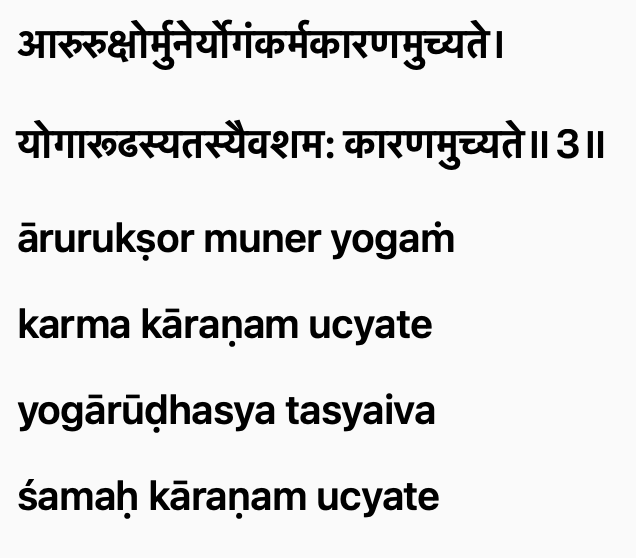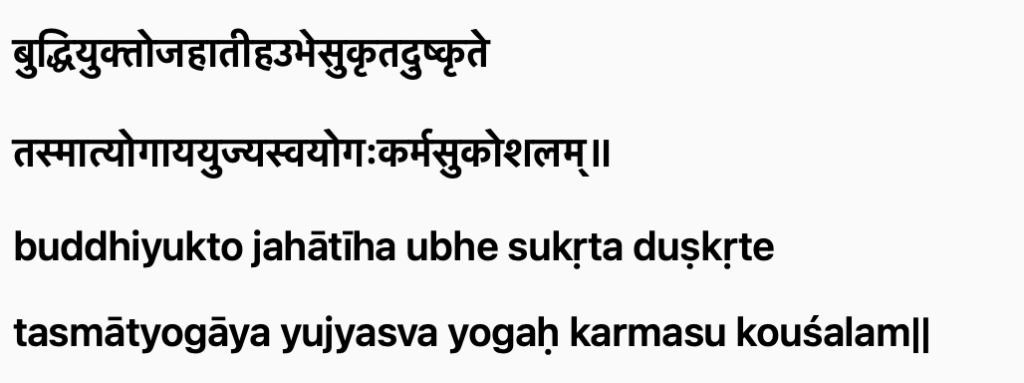Karma Yoga
Do your work and then step back
The only path to serenity
~ Lao Tzu
The Bhagavad Gita shares so much with the teachings of Patanjali’s Yoga Sutras. We would do well to study the Gita and glean it’s deep meaning and application to our practice and our lives. The Gita’s 18 chapters all expound the benefits and aim of a particular lane of yoga. Of all these practices or disciplines a few are given particular esteem towards the ultimate aim: Moksha….namely Karma Yoga, Jnana Yoga, Raja Yoga and Bhakti Yoga. It may be helpful to review here before continuing.
In the Gita, Krishna describes two paths of yoga depending on the capacity of the individual in the current life

For one who is new to the eightfold yoga system, work is said to be the means; and for one who is already elevated in yoga, cessation of all mental attachments (citta vrtti nirodhah) is said to be the means.
This same sentiment is reflected in the Yoga Sutras as “Abhyasa vairagyabhyam tan nirodhah” or nirodhah is arrived at by the marriage of sustained practice and dettachment. Cessation is not immediate for most of us. It requires right effort and release.
Part 1: Yoga of Action
For the begineer yogabhyasi then karma yoga – the yoga of selfless action is prescribed as the first step. Often we hear the term karma yoga applied to people exchanging work in a yoga studio for free classes or an ashram in exchange for room and board. However this is an extremely limited use of the word at best. Karma yoga is an attitude as much as an act. This practice is not action for reciprocity sake but rather action as an attitude of service alone. As the mind is not yet stable enough to fully renouce all citta vrttis we use our daily life to prepare the mind for such endeavors. Here the action is the abhyasa and the vairagya is in the release of expectations around those actions. This is not an isolated practice but a way of being.
As Krishna tells Arjuna…

Staying within yourself, do your actions
Renouncing attachment, O Conqueror of Wealth (Arjuna);
Be the same in success or failure,
For equanimity is yoga, it is said.
~translation by Rolf Sovik
Sthah is the same root as the word sthiti or sthithau. It means “to stay” so yogasthah means to “remain in yoga” or “be established in yoga.” Being established here in karma yoga means to have an intimate relationship with observing the quality of our actions. Remember that actions can typically be placed into 3 categories punya, apunya and jivana prayatnas. The first are good deeds, the second are malicious deeds and the third is efforts to sustain life (the preferred prayatna for yoga). However there is a 4th category. This is misra or mixed. These are actions that may be good for some and bad for others and really it is this category that fits many of our actions when we are not grounded in karma yoga. For example, a parent is devoted to the wellbeing of their children. They do everything within their power to make sure that child grows to be healthy and content. However if the actions of a parent are merely for the satisfaction of seeing theirself reflected in another or to receive affection and affirmation from their offspring then there is a hefty attachment to the action of parenting. Inevitably the child cannot meet such an expectation. So while the actions of the parent may be punya for the child they have apunya effects on the parent who suffers as a result of an unmet ideal. Or sometimes vice versa.
Patanjali describes the motivation for such non yogic actions in sutra 2.34

- vitarka: counter tendencies
- himsadayah: harm, violence
- krta: conflict source
- karita:influence another (to do harm)
- anumodita: instigator
- lobha: greed
- krodha: anger
- moha: infatuation
- purvaka: preceeded by
- mrdu: mild
- madhya: moderate
- adhimatra: intense
- dukha: pain
- jnana: knowledge
- ananta: infinite
- phala
- iti: this is
- pratipaksa bhavanam: cultivating the opposite attitude
Himsa and its forms (krta, karita, anumodita) are preceeded by the following tendencies: greed (lobha), anger (krodha) and infatuation (moha) and can be mild, moderate or intense in the pain and ignorance they propogate. While practicing ashtanga yoga one should endeavor to contemplate the counter tendency of non-violence whenevery faced with these forms and their tendencies.
Karma yoga therefore is doing our duty not from the seat of expectation or agenda. These expectations often have seed (whether subtle or intense) in greed, anger and infatuation. So renouncing the results but not the actions is key. Karma yoga is action for selfless service…or as Ramaswami says efficient action. It is bringing the recipe of abhyasa + vairagya into the entirety of our life. It is an attitude not a technique alone. While many schools of ethics, religions etc tout good deeds as the pinnacle of life yoga and the gita say otherwise…

With focused intellect (buddhiyuktah) give up both good and bad activities (sukrita dushkrita). Then engage (yujyasva) in Yoga (Yogaya). Of all activities( karmasu, 4 types of activities) Yoga is the superior (kausalam)
~translation Srivatsa Ramaswami
The four types of activities being good, bad, mixed and yogic. Karma yoga is preferred for the above stated reasons.
In karma yoga our activites are done selflessly (as in not for the sake of this body/mind) and not for any particular result. The focus is jivana prayatna or yogic effort. We may do good deeds but we do not claim them as our own. They are merely our duty. The message then is: Do your duty without seeking anything in return or attaching to the results; do not claim as yours what never was. We may see this as the ultimate practice of asteya (non-stealing). Otherwise the wheel of samsara continues to spin. For many karma yoga leads to bhakti yoga- action in service of the divine. And so Krishna advises Arjuna again, as he does in every chapter, not to give up his duty but to become a yogi.
The many meanings of Karma yoga:
Selfless service is described in many ways. See what resonates with you. For example:
- the foundation for all yoga (remember abhyasa + vairagya)
- action done with awareness of the atman/purusa rather that for the sake of the changeable prakriti. the foundation for jnana yoga
- putting our best foot forward in whatever circustance as a divine offering. Therefore karma yoga is the foundation of bhakti yoga.
- renunciation of the fruits of our actions. Vairagya
- action aligned with one’s dharma. Not giving up our duties in this life but rather commiting to appropriate action in accordance with our dharma. dharmo rakshati rakshitah: “Dharma will back/protect the one who backs/observes dharma” (famous verse from the Manusmriti of the Mahabharata translated by Srivatsa Ramaswami)
- actions to purify the ego. a similar intention to kriya yoga which removes the kleshas
- ethical actions, but again without attachement to the results- so in alignment with yama/niyama
Lokah Samastah Sukhino Bhavantu
May all beings be happy and free. May my thoughts, words and actions contribute to freedom for all.
See you tomorrow,
Jennifer
